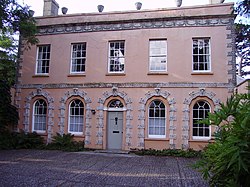Eleanor Coade | |
|---|---|
| Born | 3 June 1733 Exeter, Devon, England |
| Died | 18 November 1821 (aged 88) Camberwell, London, England |
| Resting place | Bunhill Fields cemetery, London |
| Occupation(s) | Business woman, neoclassical statuary sculptor and manufacturer |

Eleanor Coade[a] (3 or 24 June 1733 – c.18 November 1821)[1][b][2] was a British businesswoman known for manufacturing Neoclassical statues, architectural decorations and garden ornaments made of Lithodipyra (Coade stone) for over 50 years from 1769 until her death. She should not be confused or conflated with her mother, also named Eleanor.[c][d][e][f]
Lithodipyra ("stone fired twice") was a high-quality, durable moulded weather-resistant, stoneware; statues and decorative features from this still look almost new today. Coade did not invent 'artificial stone', as various inferior quality precursors had been both patented and manufactured over the previous forty years, but she probably perfected both the formulation and the firing process.
She combined high-quality manufacturing and artistic taste, together with entrepreneurial, business and marketing skills, to create the overwhelmingly successful stone products of her age. She produced stoneware for St George's Chapel, Windsor; The Royal Pavilion, Brighton; Carlton House, London and the Royal Naval College, Greenwich. Shortly after her death, her company produced a large quantity of stoneware used in the refurbishment of Buckingham Palace.[1][5]
Born in Exeter to two families of wool merchants and weavers, she ran her business, "Coade's Artificial Stone Manufactory", "Coade and Sealy" and latterly "Coade" (by appointment to George III and the Prince Regent), for fifty years in Lambeth, London. A devout Baptist, she died unmarried in Camberwell.
In 1784 an uncle, Samuel Coade, gave her Belmont House, a holiday villa in Lyme Regis, her late father's town of origin. She decorated the house extensively with Coade stone.[1][6]
Cite error: There are <ref group=lower-alpha> tags or {{efn}} templates on this page, but the references will not show without a {{reflist|group=lower-alpha}} template or {{notelist}} template (see the help page).
- ^ a b c d "Eleanor Coade", Alison Kelly, Oxford National Dictionary of Biography - correction per Caroline Stanford
- ^ T. Neuman (1823). The London Gazette, Part 2. p. 1922.
- ^ "Coade's Artificial Stone Works | British History Online". www.british-history.ac.uk.
- ^ Obituary: Eleanor Coade, The Gentleman's Magazine, Volume 130, Por John Nichols.
- ^ Cite error: The named reference
Addidiwas invoked but never defined (see the help page). - ^ "Belmont House" Archived 2 November 2007 at the Wayback Machine, Landmark Trust